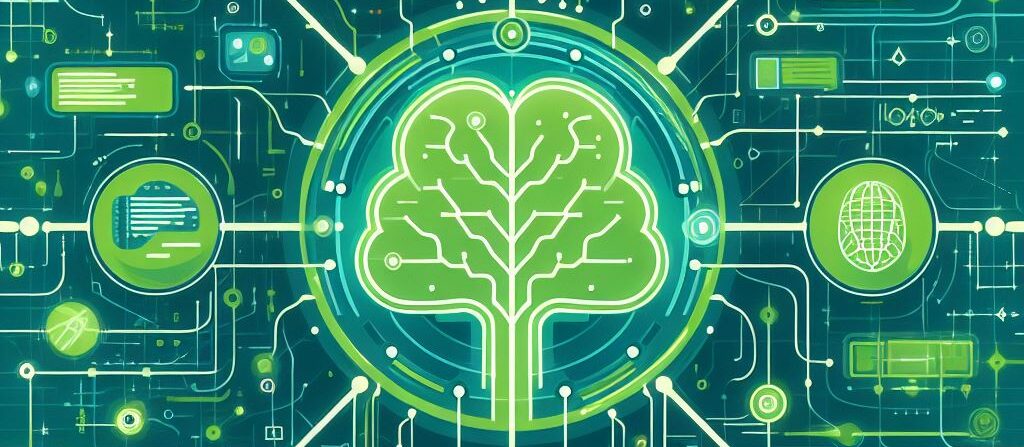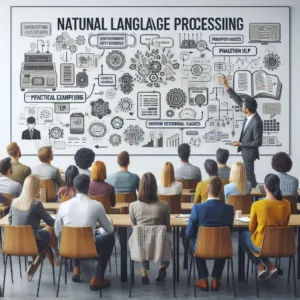In the realm of artificial intelligence and machine learning, Natural Language Processing (NLP) stands as a foundational technology, revolutionizing the way machines comprehend and interact with human language. From deciphering sentiments to enabling seamless communication across languages, NLP has permeated various real-world applications, shaping industries and enhancing user experiences.
This tutorial series embarks on a journey to unravel the intricacies of NLP, catering to both beginners and seasoned enthusiasts alike. By delving into the complexities of this vibrant field, readers will gain a comprehensive understanding of its significance and practical implementation.
Throughout this series, we’ll explore the diverse landscape of NLP, from sentiment analysis to machine translation and the development of intelligently chatbots. By the end, readers will be equipped with the knowledge and tools necessary to harness the full potential of NLP in their own projects and endeavors.
Join us as we embark on this enlightening exploration of Natural Language Processing, where the fusion of human language and machine intelligence opens doors to endless possibilities.
What is Natural Language Processing?
Natural Language Processing (NLP) is a field of artificial intelligence (AI) focused on enabling computers to understand, interpret, and generate human language in a way that is both meaningful and contextually appropriate. At its core, NLP aims to bridge the gap between human communication and computational understanding, revolutionizing the way we interact with technology.

Definition and Goals of NLP:
NLP encompasses a wide range of techniques and algorithms designed to facilitate communication between humans and machines through natural language. Its primary goals include:
Understanding: NLP seeks to enable computers to understand the nuances of human language, including grammar, semantics, and context. This involves tasks such as parsing sentences, identifying entities, and extracting relevant information.
Interpretation: Once understood, NLP enables computers to interpret human language, extracting insights and deriving meaningful conclusions. This may involve tasks such as sentiment analysis, topic modeling, and named entity recognition.
Generation: Beyond understanding, NLP empowers computers to generate human-like language, whether in the form of coherent responses, summaries, or translations. This requires an understanding of language structure, semantics, and pragmatics.
How NLP Works:
NLP achieves its goals through a combination of linguistics, statistics, and machine learning techniques. By analyzing vast volumes of text data, NLP algorithms learn patterns and relationships inherent in language, allowing them to make predictions and generate responses.
Key components of NLP include:
Tokenization: Breaking text into smaller units, such as words or phrases, for analysis. Syntax Analysis: Parsing sentences to understand syntax and relationships between words. Semantic Analysis: Extracting meaning from text, considering context and intent. Machine Learning Models: Using algorithms trained on labeled data to perform tasks like classification, translation, and summarization.
Historical Background and Advancement:
The roots of NLP can be traced back to the 1950s, with the early development of computer-based language processing systems. However, it wasn’t until the advent of statistical and machine learning approaches in the 1990s that significant advancements were made. Breakthroughs in areas such as deep learning and neural networks have further propelled the field forward, enabling more accurate and sophisticated language understanding.
Over the years, NLP has seen extensive adoption across various industries and applications, including search engines, virtual assistants, sentiment analysis tools, and language translation services. As technology continues to advance, so does the potential of NLP, promising even greater advancements in the future.
In conclusion, Natural Language Processing represents a significant intersection of linguistics, artificial intelligence, and computer science, with the overarching goal of facilitating seamless communication between humans and machines. By understanding the fundamentals of NLP and its evolution, we can better appreciate its significance in shaping the future of technology and human interaction.
Fundamentals of Natural Language Processing
Natural Language Processing (NLP) serves as the foundation of modern artificial intelligence, enabling machines to understand, interpret, and generate human language. To grasp the essence of NLP, it’s essential to familiarize ourselves with its fundamental concepts, tasks, and the inherent challenges it faces.

Essential Concepts and Terminology:
Corpus: A collection of text documents used for analysis and training NLP models. Tokenization: The process of breaking text into smaller units, such as words or phrases, for analysis. Stemming: Reducing words to their root or base form by removing suffixes or prefixes. Lemmatization: Similar to stemming but aims to reduce words to their canonical form (lemma) based on their dictionary meanings. Part-of-Speech (POS) Labeling: Assigning grammatical labels to words in a sentence, such as nouns, verbs, adjectives, etc.
Overview of Key Tasks in NLP:
Text Classification: Categorizing text into predefined classes or categories based on its content or context, such as spam detection, sentiment analysis, or topic classification. Named Entity Recognition (NER): Identifying and categorizing entities mentioned in text, such as names of people, organizations, locations, etc. Part-of-Speech (POS) Labeling: Assigning grammatical labels to words in a sentence, such as nouns, verbs, adjectives, etc., to understand their syntactic roles. Sentiment Analysis: Determining the sentiment or opinion expressed in text, whether it’s positive, negative, or neutral. Machine Translation: Translating text from one language to another while preserving its meaning and context. Text Summarization: Generating concise summaries of longer text documents or articles. Question Answering: Automatically extracting relevant information from text to answer user queries.
Challenges and Complexities:
Despite its advancements, NLP faces several challenges and complexities due to the inherent ambiguity and variability of natural language:
Uncertainty: Words and phrases can have multiple meanings or interpretations depending on context, making accurate understanding difficult. Variability: Language usage varies across different regions, cultures, and contexts, posing challenges for NLP models trained on specific datasets. Data Sparsity: NLP tasks often require large amounts of annotated data for training, which may not always be readily available or easy to obtain. Semantic Understanding: Capturing the nuanced meanings and nuances conveyed in natural language requires advanced semantic analysis and reasoning capabilities.
In summary, mastering the fundamentals of Natural Language Processing involves understanding the basic concepts, tasks, and challenges involved in processing human language. By delving into these foundational aspects, we lay the groundwork for building advanced NLP systems capable of tackling real-world problems and enhancing human-computer interaction.
NLP Tools and Libraries:
Natural Language Processing (NLP) has seen a surge in popularity, largely thanks to the availability of powerful tools and libraries that simplify complex language processing tasks. In this guide, we’ll delve into some of the most popular NLP libraries, compare their features, and provide insights on installing and setting them up for various programming languages, with a focus on Python.

Introduction to Popular NLP Tools and Libraries:
NLTK (Natural Language Toolkit):
NLTK is one of the oldest and most widely used NLP libraries in Python. It offers a wide range of functionalities for tasks such as tokenization, stemming, POS tagging, and parsing. NLTK also includes resources like corpora and lexical resources for NLP research and experimentation.
SpaCy:
SpaCy is known for its speed and efficiency, making it suitable for processing large volumes of text. It provides pre-trained models for tasks like entity recognition, dependency parsing, and named entity recognition. SpaCy emphasizes ease of use and integrates seamlessly with other libraries and frameworks.
Gensim:
Gensim specializes in topic modeling and document similarity tasks. It offers implementations of popular algorithms like Latent Semantic Analysis (LSA) and Latent Dirichlet Allocation (LDA). Gensim is particularly useful for extracting insights from large text corpora and building semantic representations.
TensorFlow NLP:
TensorFlow NLP, part of the TensorFlow ecosystem, provides tools and utilities for building neural network models for NLP tasks. It offers pre-trained models and modules for tasks like text classification, sequence labeling, and language generation. TensorFlow NLP leverages the power of deep learning to achieve state-of-the-art results in various NLP applications.
Comparison of Different Tools and Their Features:
Ease of Use: NLTK and SpaCy are known for their user-friendly interfaces and comprehensive documentation, making them ideal for beginners. Gensim focuses more on specific tasks like topic modeling, while TensorFlow NLP requires a deeper understanding of neural networks and machine learning concepts.
Performance: SpaCy is renowned for its speed and efficiency, making it a preferred choice for handling large datasets. NLTK, while versatile, may lag behind in terms of performance for certain tasks. TensorFlow NLP offers scalability and performance benefits but may require more computational resources.
Task Specificity: Each library has its strengths and weaknesses. NLTK is versatile and suitable for a wide range of NLP tasks. SpaCy excels in tasks like named entity recognition and dependency parsing. Gensim is specialized in topic modeling, while TensorFlow NLP is ideal for deep learning-based approaches.
How to Install and Set Up NLP Libraries for Python:
Installing and setting up NLP libraries in Python is straightforward using package managers like pip. Here’s a basic guide:
NLTK: Install NLTK using pip and download NLTK data.
SpaCy: Install SpaCy using pip and download SpaCy models.
Gensim: Install Gensim using pip.
TensorFlow NLP: Install TensorFlow and TensorFlow NLP using pip.
Once installed, you can start using these libraries in your Python projects for various NLP tasks.
In conclusion, NLP libraries play a crucial role in streamlining and accelerating language processing tasks. By understanding their features, capabilities, and installation procedures, developers can leverage these tools to build robust NLP applications and solutions. Whether you are a novice or an experienced practitioner, exploring these libraries opens up a world of possibilities in the realm of Natural Language Processing.
Techniques for Cleaning and Preprocessing Text Data:
Several techniques are used in the preprocessing stage to convert raw text into a structured and consistent format suitable for NLP analysis. Common techniques include:
Removing Stopwords: Stopwords are commonly occurring words in a language (e.g., “the,” “is,” “which”) that add little semantic value to the text. Removing stopwords helps reduce noise and focus on important content.
Removing Punctuation and Special Characters: Punctuation marks and special characters can disrupt the analysis process. Removing them ensures that the text remains clean and uniform throughout.
Lowercase Conversion: Converting all text to lowercase normalizes the text, preventing duplication of words with different cases and improving the accuracy of NLP tasks like word frequency analysis.
Tokenization: Tokenization involves breaking down text into smaller units, such as words or phrases, for analysis. This step is crucial for various NLP tasks, including sentiment analysis and text classification.
Stemming and Lemmatization: These techniques aim to reduce words to their base or root forms, aiding in reducing redundancy and improving efficiency in text analysis.
Hands-on Examples Using NLP Libraries:
Illustrating these preprocessing techniques can be effectively done using popular NLP libraries such as NLTK (Natural Language Toolkit) and SpaCy. Through hands-on examples, practitioners can gain a practical understanding of how to implement these preprocessing steps effectively, ensuring that their text data is clean and ready for advanced NLP analysis.

Conclusion:
Text preprocessing lays the foundation for effective NLP analysis, ensuring that the data is clean, consistent, and optimized for further processing. By mastering these preprocessing techniques and leveraging NLP libraries, professionals can unlock the full potential of their text data, leading to more accurate insights and better-performing NLP models. Embracing the importance of preprocessing is key to achieving success in the dynamic field of Natural Language Processing.
Understanding Different Text Analysis Techniques:
In the realm of Natural Language Processing (NLP), understanding various text analysis techniques is essential for extracting meaningful insights from textual data. This guide explores different methods and approaches for text representation, sentiment analysis, Named Entity Recognition (NER), and Part-of-Speech (POS) Tagging, shedding light on their applications, pros, and cons, along with practical implementation examples.
Text Representation:
Text representation techniques play a crucial role in converting raw text into a format suitable for computational analysis. Three primary methods include:
Bag-of-Words: This approach represents text as a collection of words, disregarding syntax and word order. While simple and effective, it fails to capture semantic relationships between words.
TF-IDF (Term Frequency-Inverse Document Frequency): TF-IDF assigns weights to words based on their frequency in a document relative to the entire corpus. It helps identify the importance of words in a document but may struggle with capturing semantic meaning.
Word Embeddings (Word2Vec, GloVe): Word embeddings represent words as dense vectors in a continuous vector space, capturing semantic relationships between words. Models like Word2Vec and GloVe learn word embeddings from large text corpora, enabling more nuanced analysis.
Sentiment Analysis:
Sentiment analysis involves determining the sentiment expressed in a piece of text, whether it’s positive, negative, or neutral. Techniques for sentiment analysis include:
Lexicon-based Approaches: These techniques rely on sentiment dictionaries or lexicons to assign sentiment scores to words. While straightforward, they may struggle with context-dependent sentiments.
Machine Learning-based Approaches: Machine learning models, such as Support Vector Machines (SVM) or Recurrent Neural Networks (RNNs), learn patterns from labeled data to classify sentiment. They offer flexibility and can capture complex relationships but require substantial labeled data for training.
Deep Learning-based Approaches: Deep learning models, such as Convolutional Neural Networks (CNNs) or Long Short-Term Memory (LSTM) networks, use neural architectures to capture hierarchical representations of text, achieving state-of-the-art performance in sentiment analysis tasks.
Named Entity Recognition (NER):
NER involves identifying and categorizing named entities mentioned in text, such as names of people, organizations, locations, etc. Methods for NER include:
Rule-based Approaches: These methods use handcrafted rules and patterns to identify named entities based on linguistic features. While interpretable, they may struggle with handling variations and inconsistencies in text.
Machine Learning-based Approaches: Machine learning models, such as Conditional Random Fields (CRFs) or Bidirectional LSTMs, learn to recognize named entities from labeled data. They offer more flexibility and can adapt to diverse text domains.

Part-of-Speech Tagging (POS Tagging):
POS tagging assigns grammatical tags to words in a sentence, indicating their syntactic roles. Techniques for POS tagging include:
Rule-based Tagging: These techniques rely on predefined rules and linguistic patterns to assign POS tags to words. While fast and interpretable, they may lack accuracy in handling ambiguous cases.
Statistical Tagging: Statistical models, such as Hidden Markov Models (HMMs) or Maximum Entropy Markov Models (MEMMs), learn POS tagging probabilities from annotated data, offering better accuracy and generalization.
In conclusion, understanding different text analysis techniques is essential for effectively processing and extracting insights from textual data. By exploring various methods and approaches, practitioners can choose the most suitable techniques for their specific NLP tasks, leading to more accurate and reliable results in natural language understanding and processing
AI Resources and Insights
- AI Art Generator on Canva: Explore how to create art with AI on Canva.
- NVIDIA Startups: Discover opportunities for startups with NVIDIA.
- Konverge AI: Learn how Konverge AI can transform your business.
- Heygen Pricing: Check out Heygen’s pricing for AI solutions.
- DataCentric AI: Explore the latest AI trends on DataCentric AI.
- Google Cloud Conversational AI: Discover Google Cloud’s conversational AI solutions.
- Amazon Web Services (AWS): Explore Amazon Web Services’ AI services.
- Marketing AI Institute: Learn more about AI-powered marketing at the Marketing AI Institute.
- Harvard Business Review – AI Marketing Strategy: Read about designing an AI marketing strategy on Harvard Business Review.
- SAS – AI Marketing Future: Discover what the future holds for AI marketing on SAS.
- Sprout Social AI Marketing Tools: Explore AI marketing tools from Sprout Social.
- Pixlr Image Generator: Create unique images with Pixlr’s image generator.
- Creative Writing Prompts on AI UpTrend: Explore creative writing prompts powered by AI on AI UpTrend.
- AI Trends on AI UpTrend: Discover the latest AI trends on AI UpTrend.
- AI Insights on AI UpTrend: Explore the latest advancements in AI on AI UpTrend.
- AI Tools on AI UpTrend: Discover a variety of AI tools on AI UpTrend.
- AI Tutorials on AI UpTrend: Explore AI tutorials to deepen your knowledge on AI UpTrend.





























